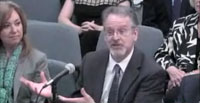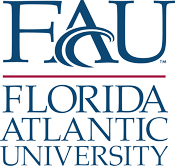 April 23, 2014 - On April 22, Dr. Frederick Bloetscher (FAU) testified to the Science and Space Sub-committee of the Commerce, Science and Transportation committee for the US Senate on the impacts of sea level rise. He noted that occasional flooding is not new to Florida, but the increasing frequency we currently experience is related to sea level rise, not just along the coast, but for large expanses of developed property inland due to topography and groundwater levels. As a result, the challenge for water managers in the state, especially in southeast Florida, is to control the groundwater table, because control of the water table is essential to prevent flooding of the low terrain. He noted that in Miami Beach, as elsewhere in Florida, the lowest lying areas are the roadways, which are also the location of electrical, water, sewer, phone and drainage infrastructure. Fortunately given the current Federally funded special imagery and NOAA data systems we are able to predict pretty accurately where flooding will occur. Linking that information with our detailed projections of sea level rise impacts we can begin now to map vulnerability and build adaptive measures into every action and plan we undertake.
April 23, 2014 - On April 22, Dr. Frederick Bloetscher (FAU) testified to the Science and Space Sub-committee of the Commerce, Science and Transportation committee for the US Senate on the impacts of sea level rise. He noted that occasional flooding is not new to Florida, but the increasing frequency we currently experience is related to sea level rise, not just along the coast, but for large expanses of developed property inland due to topography and groundwater levels. As a result, the challenge for water managers in the state, especially in southeast Florida, is to control the groundwater table, because control of the water table is essential to prevent flooding of the low terrain. He noted that in Miami Beach, as elsewhere in Florida, the lowest lying areas are the roadways, which are also the location of electrical, water, sewer, phone and drainage infrastructure. Fortunately given the current Federally funded special imagery and NOAA data systems we are able to predict pretty accurately where flooding will occur. Linking that information with our detailed projections of sea level rise impacts we can begin now to map vulnerability and build adaptive measures into every action and plan we undertake. He noted that he is positive on Florida’s future. Our best option is adaptation and there are many options available - for example we can install more coastal salinity structures, raise road beds, abandon some local roads, increase storm water pumping, add storm water retention etc. to address many of the problems. FAU has developed a toolbox of these options that can be applied to address these adaptation demands, resulting in an approach that will need a more managed integrated water system, more operations and inevitably more dollars. Much of the actual needs are local, but the problem is regional and requires a concerted effort of federal, state and local agencies and the private sector to address the scales of the problem. A community can address the local problems, but the regional canals, barriers, etc., are beyond the scope of individual agencies. Collaboration and discussion are needed. The Four County Compact is an excellent example, but the longer term solutions need the state and federal agencies and the related dollars to address larger impacts.
The needs will be large - in the tens of billions. But there are two things in south Florida’s favor – time and money. The expenditures are over many, many years. Most important in the near term need is the early planning and identification of critical components of infrastructure and policy needs and timing for same. At risk are nearly 6 million of Floridians their economy and lifestyle, $3.7 trillion in property (2012) in south east Florida alone and a $260 billion annual economy. All of these are expected to continue to increase assuming the appropriate plans are made to adapt to the changing sea level. Protection of the area for the next 100-150 years is achievable as long as we have the science, the understanding and the will to do it. Plan now, and over the rest of this century starting now we can raise those billions of dollars needed.












